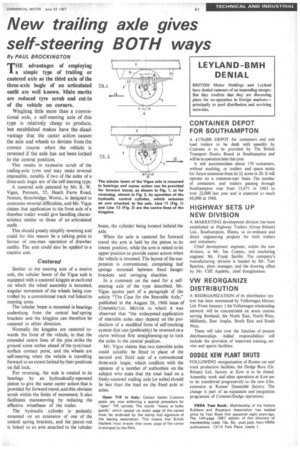New trailing axle gives self-steering BOTH ways
Page 43

If you've noticed an error in this article please click here to report it so we can fix it.
By PAUL BROCKINGTON
THE advantages of employing a simple type of trailing or castered axle as the third axle of the three-axle bogie of an articulated outfit are well known. Main merits are reduced tyre scrub and cut-in of the vehicle on corners.
Weighing little more than a conventional axle, a self-steering axle of this type is relatively cheap to produce, but established makes have the disadvantage that the caster action causes the axle and wheels to deviate from the correct course when the vehicle is reversed if the axle has not been locked in the central position.
This results in excessive scrub of the trailing-axle tyres and may make reversal impossible, notably if two of the axles of a three-axle bogie are of the self-steering type.
A castered axle patented by Mr. K. W. Vigus, Pennant, 55, Heath Farm Road, Norton, Stourbridge, Worcs., is designed to overcome reversal difficulties, and Mr. Vigus claims that application to the front axle of a drawbar trailer would give handling characteristics similar to those of an articulated outfit.
This should greatly simplify reversing and could for this reason be a talking point in favour of one-man operation of drawbar outfits. The axle could also be applied to a tractive unit.
Castered Similar to the steering axle of a motive unit, the tubular beam of the Vigus axle is equipped with a castered kingpin at each end on which the wheel assembly is mounted, angular movement of the wheels being controlled by a conventional track rod linked to steering arms.
The tubular beam is mounted in bearings underslung from the central leaf-spring brackets and the kingpins can therefore be castered in either direction.
Normally the kingpins are castered towards the front of the vehicle, in that the extended centre lines of the pins strike the ground some inches ahead of the tyre/roadsurface contact point, and the wheels are self-steering when the vehicle is travelling forward to an extent limited by their positions on full lock.
For reversing, the axle is rotated in its bearings by an hydraulically-operated piston to give the same caster action that is provided for forward travel, and this obviates scrub within the limits of movement. It also facilitates manoeuvring by reducing the effective wheelbase of the trailer.
The hydraulic cylinder is pedantly mounted on an extension of one of the central spring brackets, and the piston rod is linked to an arm attached to the tubular beam, the cylinder being located behind the axle.
When the axle is castered for forward travel the arm is held by the piston in its lowest position, while the arm is raised to its upper position to provide caster action when the vehicle is reversed. The layout of the suspension is conventional, comprising leaf springs mounted between fixed hanger brackets and swinging shackles.
In a comment on the need for a selfsteering axle of the type described, Mr. Vigus quotes part of a paragraph of the article "The Case for the Steerable Axle," published in the August 26, 1966 issue of COMMERCIAL MOTOR in which it was observed that "the widespread application of steerable axles may depend on the production of a modified form of self-tracking system that can (preferably) be reversed on a curve without first straightening-up to lock the axles in the central position.
Mr. Vigus claims that two steerable axles could suitably be fitted in place of the second and third axle of a conventional three-axle bogie, which conflicts with the opinion of a number of authorities on the subject who state that the total load on a freely-castered trailing axle (or axles) should be less than the load on the fixed axle or axles.
Open TIR in Italy: Certain Italian Customs posts are now enforcing a special procedure for "open" TIP carnets. The words "heavy or bulky goods" which appear on every page of the carnet must be endorsed by the stamp and signature of the issuing association. This means that British hauliers must ensure that every page of the carnet is sta mped by the R HA.












































































































